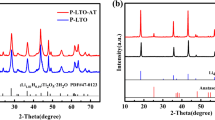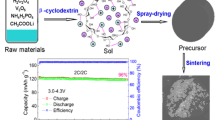Abstract
TiNb2O7 (TNO) has been regarded as a promising anode material for high-power lithium–ion batteries due to its high theoretical capacity and work voltage (387.6 mA h g−1, 1.6 V vs. Li+/Li). Herein, a series of microspherical TNO anode materials are synthesized by a facile solvothermal method, and the effect of solvothermal time on the microstructure and electrochemical performance is investigated. Specifically, when the solvothermal time is 12 h, the TNO microsphere (TNO-12) exhibits higher specific surface area and more reasonable pore size distribution. As a result, TNO-12 anode delivers a high reversible discharge capacity of 299.87 mA h g−1 with a superior initial coulombic efficiency above 98.5%, excellent cycling capacity retention of 80.15% after 100 cycles at 0.5 C (150 mA g−1), and good rate performance at 0.1–2 C. Most importantly, the full cell constructed with TNO anode and commercial oxide cathode (LiNi0.6Mn0.4O2/LiMn2O4 with a mass ratio of 85: 15) exhibits excellent cycling stability at high current densities (79.14% after 100 cycles at 0.5 C). This study optimizes the synthesis process for high-performance microspherical TNOs, providing new insights for the next generation of commercial anodes.






Similar content being viewed by others

References
Yang X-G, Liu T, Wang C-Y (2021) Thermally modulated lithium iron phosphate batteries for mass-market electric vehicles. Nat Energy 6:176–185. https://doi.org/10.1038/s41560-020-00757-7
Liu Y-N, Xiao Z, Zhang W-K, Zhang J, Huang H, Gan Y-P, He X-P, Kumar GG, Xia Y (2022) Poly(m-phenylene isophthalamide)-reinforced polyethylene oxide composite electrolyte with high mechanical strength and thermostability for all-solid-state lithium metal batteries. Rare Met 41:3762–3773. https://doi.org/10.1007/s12598-022-02065-3
Su H, Liu Y, Zhong Y, Li J, Wang X, Xia X, Gu C, Tu J (2022) Stabilizing the interphase between Li and Argyrodite electrolyte through synergistic phosphating process for all-solid-state lithium batteries. Nano Energy 96:107104. https://doi.org/10.1016/j.nanoen.2022.107104
Liu P, Su H, Liu Y, Zhong Y, Xian C, Zhang Y, Wang X, Xia X, Tu J (2022) LiBr–LiF-rich solid–electrolyte interface layer on lithiophilic 3D framework for enhanced lithium metal anode. Small Struct 3:2200010. https://doi.org/10.1002/sstr.202200010
Wang J, Wang Z, Ni J, Li L (2022) Electrospun materials for batteries moving beyond lithium-ion technologies. Electrochem Energy Rev 5:211–241. https://doi.org/10.1007/s41918-021-00103-9
Jiang Y, Wang Y, Ni J, Li L (2021) Molybdenum-based materials for sodium-ion batteries Infomat 3:339–352. https://doi.org/10.1002/inf2.12175
Chen AQ, Wang K, Li JJ, Mao QZ, Xiao Z, Zhu DM, Wang GG, Liao P, He JR, You Y, Xia Y (2020) The formation, detriment and solution of residual lithium compounds on Ni-rich layered oxides in lithium-ion batteries. Front Energy Res 8:593009. https://doi.org/10.3389/fenrg.2020.593009
Xia Y, Chen AQ, Wang K, Mao QZ, Huang H, Zhang J, He XP, Gan YP, Xiao Z, Zhang WK (2022) Industrial modification comparison of Ni-Rich cathode materials towards enhanced surface chemical stability against ambient air for advanced lithium-ion batteries. Chem Eng J 450:138382. https://doi.org/10.1016/j.cej.2022.138382
Xia Y, Ren XH, Xiao Z, Gan YP, Zhang J, Huang H, He XP, Mao QZ, Wang GG, Zhang WK (2022) Spinel LiNi0.5Mn1.5O4 shell enables Ni-rich layered oxide cathode with improved cycling stability and rate capability for high-energy lithium-ion batteries. Electrochimica Acta 418:140352. https://doi.org/10.1016/j.electacta.2022.140352
Jiao C, Qiuying X, Wei L, Hui X (2022) Enhancing the lithium storage capability of TiO2 thin film for all-solid-state microbatteries via amorphous-crystalline heterostructure design. Appl Phys Lett 121:131901. https://doi.org/10.1063/5.0117083
Zhu S, Sheng J, Ni J, Li Y (2021) 3D vertical arrays of nanomaterials for microscaled energy storage devices. Acc Mater Res 2:1215–1226. https://doi.org/10.1021/accountsmr.1c00175
Zhang Y, Zhang Q, Wang J, Sheng L, Wang L, Xie Y, Hao Y, Dong L, He X (2022) Insight mechanism of nano iron difluoride cathode material for high-energy lithium-ion batteries: a review. J Solid State Electrochem 26:2601–2626. https://doi.org/10.1007/s10008-022-05287-8
Reddy MV, Subba Rao GV, Chowdari BVR (2013) Metal oxides and oxysalts as anode materials for Li ion batteries. Chem Rev 113:5364–5457. https://doi.org/10.1021/cr3001884
Thackeray MM, Amine K (2021) Li4Ti5O12 spinel anodes. Nat Energy 6:683–683. https://doi.org/10.1038/s41560-021-00829-2
Verde MG, Baggetto L, Balke N, Veith GM, Seo JK, Wang Z, Meng YS (2016) Elucidating the phase transformation of Li4Ti5O12 lithiation at the nanoscale. ACS Nano 10:4312–4321. https://doi.org/10.1021/acsnano.5b07875
Yuan T, Tan Z, Ma C, Yang J, Ma Z-F, Zheng S (2017) Challenges of spinel Li4Ti5O12 for lithium-ion battery industrial applications. Adv Energy Mater 7:1601625. https://doi.org/10.1002/aenm.201601625
Tang Y, Deng S, Shi S, Wu L, Wang G, Pan G, Lin S, Xia X (2020) Ultrafast and durable lithium ion storage enabled by intertwined carbon nanofiber/Ti2Nb10O29 core-shell arrays. Electrochimica Acta 332:135433. https://doi.org/10.1016/j.electacta.2019.135433
Shen S, Zhang S, Deng S, Pan G, Wang Y, Liu Q, Wang X, Xia X, Tu J (2019) Bioinspired large-scale production of multidimensional high-rate anodes for both liquid & solid-state lithium ion batteries. J Mater Chem A 7:22958–22966. https://doi.org/10.1039/C9TA08899G
Deng S, Zhang Y, Xie D, Yang L, Wang G, Zheng X, Zhu J, Wang X, Yu Y, Pan G, Xia X, Tu J (2019) Oxygen vacancy modulated Ti2Nb10O29-x embedded onto porous bacterial cellulose carbon for highly efficient lithium ion storage. Nano Energy 58:355–364. https://doi.org/10.1016/j.nanoen.2019.01.051
Chen J, Ni M, Liu W, Xia Q, Xia H (2022) N-doped carbon-coated interconnected TiNb2O7 hollow nanospheres as advanced anodes for lithium-ion batteries. J Mater Sci 57:15502–15512. https://doi.org/10.1007/s10853-022-07610-0
Muruganantham R, Lin M-C, Wang PK, Chang BK, Liu W-R (2022) Highly effective Al-doped titanium niobate porous anode material for rechargeable high-rate Li-ion storage performance. J Taiwan Inst Chem Eng 131:104187. https://doi.org/10.1016/j.jtice.2021.104187
Aghamohammadi H; Eslami-Farsani R (2022) Effects of calcination parameters on the purity, morphology, and electrochemical properties of the synthesized TiNb2O7 by the solvothermal method as anode materials for Li-ion batteries. J Electroanalytical Chem 917:116394. https://doi.org/10.1016/j.jelechem.2022.116394
Zhang Y, Kang C, Zhao W, Sun B, Xiao X, Huo H, Ma Y, Zuo P, Lou S, Yin G (2022) Crystallographic engineering to reduce diffusion barrier for enhanced intercalation pseudocapacitance of TiNb2O7 in fast-charging batteries. Energy Storage Mater 47:178–186. https://doi.org/10.1016/j.ensm.2022.01.061
Shen S, Guo W, Xie D, Wang Y, Deng S, Zhong Y, Wang X, Xia X, Tu J (2018) A synergistic vertical graphene skeleton and S-C shell to construct high-performance TiNb2O7-based core/shell arrays. J Mater Chem A 6:20195–20204. https://doi.org/10.1039/C8TA06858E
Choi SH, Ali B, Choi KS, Hyun SK, Sim JJ, Choi WJ, Joo W, Lim JH, Lee TH, Kim TS, Park KT (2017) Reaction kinetics and morphological study of TiNb2O7 synthesized by solid-state reaction. Arch Metall Mater 2B:1051–1056. https://doi.org/10.1515/amm-2017-0152
Lu C-H, Li K-C, Balaji S, Kumar PS (2021) Agar-assisted sol-gel synthesis and electrochemical characterization of TiNb2O7 anode materials for lithium-ion batteries. Ceram Int 47:18619–18624. https://doi.org/10.1016/j.ceramint.2021.03.193
Ise K, Morimoto S, Harada Y, Takami N (2018) Large lithium storage in highly crystalline TiNb2O7 nanoparticles synthesized by a hydrothermal method as anodes for lithium-ion batteries. Solid State Ionics 320:7–15. https://doi.org/10.1016/j.ssi.2018.02.027
Cheng Q, Liang J, Lin N, Guo C, Zhu Y, Qian Y (2015) Porous TiNb2O7 Nanospheres as ultra long-life and high-power anodes for lithium-ion batteries. Electrochim Acta 176:456–462. https://doi.org/10.1016/j.electacta.2015.07.038
Li H, Shen L, Pang G, Fang S, Luo H, Yang K, Zhang X (2015) TiNb2O7 nanoparticles assembled into hierarchical microspheres as high-rate capability and long-cycle-life anode materials for lithium ion batteries. Nanoscale 7:619–624. https://doi.org/10.1039/C4NR04847D
Wu X, Miao J, Han W, Hu Y-S, Chen D, Lee J-S, Kim J, Chen L (2012) Investigation on Ti2Nb10O29 anode material for lithium-ion batteries. Electrochem Commun 25:39–42. https://doi.org/10.1016/j.elecom.2012.09.015
Li H, Shen L, Zhang X, Nie P, Chen L, Xu K (2012) Electrospun hierarchical Li4Ti4.95Nb0.05O12/carbon composite nanofibers for high rate lithium ion batteries. J Electrochem Soc159:A426. https://doi.org/10.1149/2.066204jes
Wang H, Qian R, Cheng Y, Wu H-H, Wu X, Pan K, Zhang Q (2020) Micro/nanostructured TiNb2O7-related electrode materials for high-performance electrochemical energy storage: recent advances and future prospects. J Mater Chem A 8:18425–18463. https://doi.org/10.1039/d0ta04209a
Griffith KJ, Seymour ID, Hope MA, Butala MM, Lamontagne LK, Preefer MB, Koçer CP, Henkelman G, Morris AJ, Cliffe MJ, Dutton SE, Grey CP (2019) Ionic and electronic conduction in TiNb2O7. J Am Chem Soc 141:16706–16725. https://doi.org/10.1021/jacs.9b06669
Cheng L-Q, He Y, Chen K, Ma Z, Liu R, Liu N, Deng Y (2022) Facile fabrication of a high performance TiNb2O7 anode for large-scale electrical energy storage. J Mater Chem A 10:17586–17592. https://doi.org/10.1039/D2TA03995H
Yang W, Bai C-J, Xiang W, Song Y, Xu C-L, Qiu L, He F-R, Zhang J, Sun Y, Liu Y, Zhong B-H, Wu Z-G, Guo X-D (2021) Dual-modified compact layer and superficial Ti doping for reinforced structural integrity and thermal stability of Ni-rich cathodes. ACS Appl Mater Interfaces 13:54997–55006. https://doi.org/10.1021/acsami.1c15920
Li S, Cao X, Schmidt CN, Xu Q, Uchaker E, Pei Y, Cao G (2016) TiNb2O7/graphene composites as high-rate anode materials for lithium/sodium ion batteries. J Mater Chem A 4:4242–4251. https://doi.org/10.1039/C5TA10510B
Liu W, Liu P, Mitlin D (2020) Review of emerging concepts in SEI analysis and artificial SEI membranes for lithium, sodium, and potassium metal battery anodes. Adv Energy Mater 10:2002297. https://doi.org/10.1002/aenm.202002297
Catti M, Pinus I, Knight K (2015) Lithium insertion properties of LixTiNb2O7 investigated by neutron diffraction and first-principles modelling. J Solid State Chem 229:19–25. https://doi.org/10.1016/j.jssc.2015.05.011
Fei L, Xu Y, Wu X, Li Y, Xie P, Deng S, Smirnov S, Luo H (2013) SBA-15 confined synthesis of TiNb2O7 nanoparticles for lithium-ion batteries. Nanoscale 5:11102–11107. https://doi.org/10.1039/C3NR03594H
Yao W, Liu Y, Li D, Zhang Q, Zhong S, Cheng H, Yan Z (2020) Synergistically Enhanced electrochemical performance of Ni-rich cathode materials for lithium-ion batteries by K and Ti Co-modification. J Phys Chem C 124:2346–2356. https://doi.org/10.1021/acs.jpcc.9b10526
Hu J, Li W, Duan Y, Cui S, Song X, Liu Y, Zheng J, Lin Y, Pan F (2017) Single-Particle performances and properties of LiFePO4 nanocrystals for Li-ion batteries. Adv Energy Mater 7:1601894. https://doi.org/10.1002/aenm.201601894
Funding
The work is supported by the National Natural Science Foundation of China (22279116 and U20A20253), Zhejiang Provincial Natural Science Foundation of China (LY21E020005 and LD22E020006), Science and Technology Department of Zhejiang Province (2022C01173 and 2023C01231), China Postdoctoral Science Foundation (2020M671785 and 2020T130597), and Scientific Research Project of Shaoxing City (2022B41015).
Author information
Authors and Affiliations
Contributions
Wenkui Zhang: writing—original draft and funding acquisition. Jian Bao: investigation, data curation, and writing—original draft. Chengwei Lu: investigation and data curation. Xiaozheng Zhou: formal analysis and data curation. Xinhui Xia: formal analysis and data curation. Jun Zhang: investigation and formal analysis. Xinping He: investigation and visualization. Yongping Gan: formal analysis and visualization. Hui Huang: formal analysis and data curation. Chen Wang: formal analysis and visualization. Wangjun Wan: formal analysis and data curation. Ruyi Fang: supervision and writing—review and editing. Yang Xia: supervision, funding acquisition, and conceptualization.
Corresponding authors
Ethics declarations
Conflict of interests
The authors declare no competing interests.
Additional information
Publisher's Note
Springer Nature remains neutral with regard to jurisdictional claims in published maps and institutional affiliations.
Supplementary Information
Below is the link to the electronic supplementary material.
Rights and permissions
Springer Nature or its licensor (e.g. a society or other partner) holds exclusive rights to this article under a publishing agreement with the author(s) or other rightsholder(s); author self-archiving of the accepted manuscript version of this article is solely governed by the terms of such publishing agreement and applicable law.
About this article
Cite this article
Zhang, W., Bao, J., Lu, C. et al. Solvothermal synthesis of TiNb2O7 microspheres as anodic materials for high-performance lithium–ion batteries. J Solid State Electrochem (2023). https://doi.org/10.1007/s10008-023-05545-3
Received:
Revised:
Accepted:
Published:
DOI: https://doi.org/10.1007/s10008-023-05545-3



